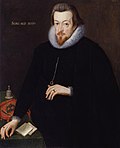Top Qs
Timeline
Chat
Perspective
List of English chief ministers
From Wikipedia, the free encyclopedia
Remove ads
Chief minister is a term used retroactively by historians to describe servants of the English monarch who presided over the government of England, and after 1707, Great Britain, before 1721. Chief ministers were usually one of the great officers of state, but it was not unusual for there to be no chief minister.[1]
This article includes a list of general references, but it lacks sufficient corresponding inline citations. (July 2017) |
Under the Norman and Angevin kings, the justiciar was often chief minister. When kings left England to oversee other parts of the Angevin Empire, the justiciar functioned as his viceroy or regent. In the 13th century, after the loss of the Angevin territories in France, the justiciar's power declined as monarchs resided permanently in England.[2]
For the next three centuries, the Lord Chancellor was most often chief minister. The chancellor served as Keeper of the Great Seal, presided over the Privy Council and Parliament, and led the High Court of Chancery. After the English Reformation, the chancellor's power shifted to the Lord High Treasurer.[3] After 1721, the office of prime minister became the head of British governments.
This list of chief ministers is organised by royal dynasty. For a list of particular governments of the Kingdom of England, see List of English ministries.
Remove ads
Anglo-Saxons
Remove ads
Normans
Remove ads
Plantagenets
Summarize
Perspective
- 1330–1340: John de Stratford, Archbishop of Canterbury
- 1367–1371: William of Wykeham, Bishop of Winchester
- 1389–1391: William of Wykeham, Bishop of Winchester
House of Lancaster
- 1413–1417: Henry Beaufort, Cardinal, Bishop of Winchester
- 1422–1435: John, Duke of Bedford, Regent, died 14 September 1435
- 1422–1437: Humphrey, Duke of Gloucester, Regent, died 23 February 1447
- 1424–1427: Henry Beaufort, Cardinal, Bishop of Winchester
- 1432–1447: Henry Beaufort, Cardinal, Bishop of Winchester
- 1447–1450: William de la Pole, 1st Duke of Suffolk
- 3 April 1454 – February 1455: Richard Plantagenet, 3rd Duke of York
- 19 November 1455 – 25 February 1456: Richard Plantagenet, 3rd Duke of York, Protector (Regent) for King Henry VI
- 1470–1471: Richard Neville, 16th Earl of Warwick †; known as Warwick the Kingmaker; killed at the Battle of Barnet
House of York
Remove ads
House of Tudor
Remove ads
House of Stuart
Remove ads
Stuart Restoration
Summarize
Perspective
This is very true: for my words are my own, and my actions are my ministers.
— King Charles II, reply to Lord Rochester's epitaph on him (Knowles 1999, p. 203)
In 1660, the leadership of the Commonwealth recalled Charles II and the chief minister became responsible to some extent to Parliament as leader of a ministry, although much of the time King Charles was in effect his own chief minister. The Glorious Revolution of 1688–89 furthered this process and by the time of Queen Anne in 1702, monarchs had little choice as to who their ministers would be.
Charles II and James II
William III and Mary II
From 1693 and during the sole reign of William III, the government was increasingly dominated by the Whig Junto.
Anne
The Kingdoms of England and Scotland united to form the Kingdom of Great Britain in 1707.
Remove ads
Hanoverian Succession
Summarize
Perspective
In the immediate aftermath of the death of Queen Anne in 1714, the monarchy was unable to function as the new King was in his domains in Hanover and did not know of his accession. As a stopgap, Parliament elected Thomas Parker, 1st Earl of Macclesfield Regent, or "acting king" until the new monarch arrived to take his crown. Later, George, Prince of Wales reigned as regent for six months from July 1716 to January 1717 when the King went to Hanover.
In the early part of the reign of George I, who could not speak English, the cabinet began meeting without the monarch present.
Following the succession of George I and the resignation of the Duke of Shrewsbury in 1714, the office of Lord High Treasurer went into permanent commission, its function undertaken by a commission of Lords of the Treasury, chaired by the First Lord of the Treasury, rather than by an individual Lord High Treasurer. From 1714 to 1717 the ministry was led by Viscount Townshend, who was nominally Northern Secretary; the Earl of Halifax, the Earl of Carlisle and Sir Robert Walpole successively served alongside Townshend as nominal First Lord of the Treasury. From 1717 to 1721 Lords Stanhope (First Lord 1717–18) and Sunderland (First Lord 1718–21) led the administration jointly, with Stanhope managing foreign affairs and Sunderland managing home affairs. Stanhope died in February 1721 and Sunderland resigned in April 1721; Townshend and Walpole returned to office.
Thus the First Lord of the Treasury came to be the most powerful minister and the prototype of Prime Minister of the United Kingdom and its dominions.
George I
Remove ads
See also
Notes
References
Wikiwand - on
Seamless Wikipedia browsing. On steroids.
Remove ads





































